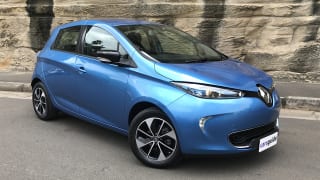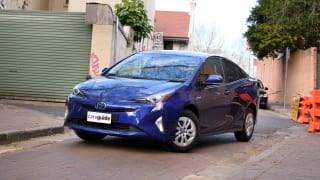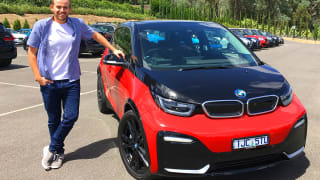The Ioniq is in the same size ballpark, with similar interior dimensions to the Mazda3, Toyota Corolla and VW Golf. And although the matte grey or gloss black ‘non-grille’ treatment on the Electric version is a notable departure, its overall fastback exterior shape and overall body kit is shared across the range.
A smoothed underbody, front wheel air curtains, sculpted side sill mouldings, an integrated tailgate spoiler and a functional diffuser contribute to a super-low drag coefficient of 0.24, in line with other eco-focused warriors like the Tesla Model S and Toyota Prius.
For city dwellers, there’s the Ioniq Electric packing a high-output electric motor, sparked up by a whopping big Lithium-ion battery under its rear-end.
It delivers zero tailpipe emissions and a real-world range of around 230km. And it’s easy to pick thanks to a grille-less nose.
Its Ioniq Plug-in sibling spreads the footprint, an ideal option for city and suburban areas with a 1.6-litre, direct-injection four-cylinder petrol engine, joined by an electric motor tipping in a solid extra boost.
Not to mention an electric-only range in excess of 60km, and claimed fuel economy of just over 1.0L/100km (mainly because the first 60-odd kays are EV-only).
Recycled plastics, sugarcane by-products, and powdered wood are variously used as ingredients in parts of the interior.
Then the Ioniq Hybrid opens up the wide-open spaces with a combination of the 1.6-litre four supported by a specifically tuned version of the electric motor.
Claimed fuel economy for the combined cycle is less than 3.5L/100km.
As you can see in the interior photos, the Electric features a lower centre console with push-buttons controlling the single-speed reduction transmission.
While the Hybrid and Plug-in have a more traditional console thanks to the intrusion of the engine and dual-clutch transmission.
So, the interior is contemporary but relatively conventional, although the materials used to create it are anything but.
Recycled plastics, sugarcane by-products, powdered wood (essentially sawdust), even volcanic stone are variously used as ingredients in parts of the interior, from soft-touch door trim panels to the headlining and carpet.
The seats in Elite models are trimmed in cloth, with the Premium’s chairs are ‘leather-appointed’. featuring leather.



























